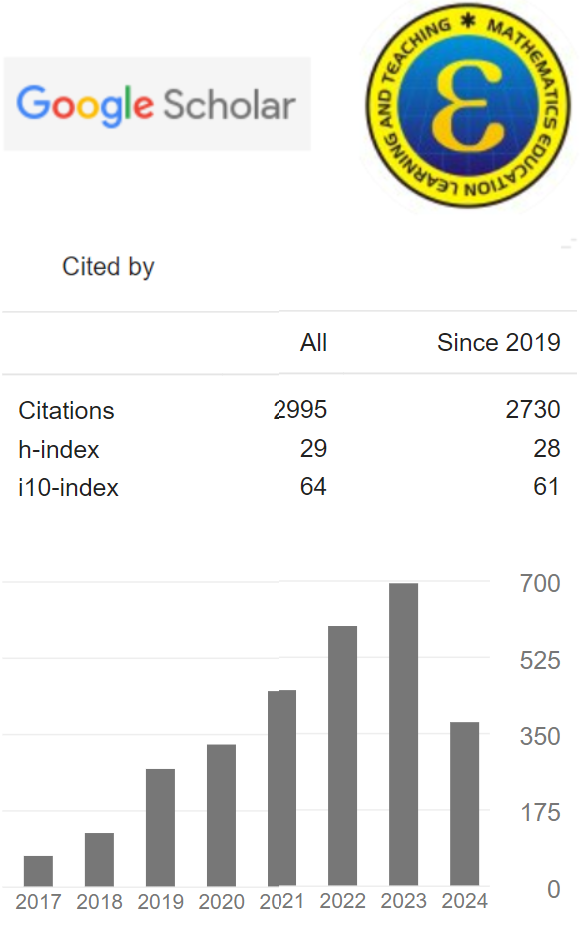Ethnomathematics : Eksploration of Traditional Crafts Tapis Lampung as Ilustration of Science, Technology, Engineering, and Mathematics (STEM)
(1) Mathematics Education, UIN Raden Intan Lampung
(*) Corresponding Author
Abstract
This study aims to exploration of traditional crafts Tapis Lampung as ilustration STEM. This research is a qualitative research with an ethnographic approach. The results showed that (1) Science: as an illustration of the ability of scientific knowledge and biological acculturation processes found in animal motive that describe the elements of science, such as the Tapis Tuho motive which has dragon animal motives, aro wood, stars silver, and sasab titled. (2) Technology: as an illustration of new technologies emerging from globalization with the entry of Islam in Lampung, the implications for communication and traffic between the Indonesian archipelago so that the use of shipping transportation is needed, can be explored from the existence of a Tapis Single Ship which shows the diversity of forms and construction. (3) Technology: as an illustration of engineering technology that is developed through an design process by integrating other elements, it can be explored from the mountains motives, dragon ship motives, and hill motives that resemble bridges. (4) Mathematics: as a geometrical illustration of transformation, which can be expressed as a form of translation, rotation), reflection, and dilation.. Through the investigation of Tapis Lampung, it can be used as a source to disseminate and provide information about Indonesian local wisdom to the world.
Keywords
Full Text:
PDFReferences
Becker, K., & Park, K. (2011). Effects of integrative approaches among science, technology, engineering, and mathematics (STEM) subjects on students’ learning: A preliminary meta-analysis. Journal of STEM Education: Innovations & Research, 12.
Chen, X. (2009). Students Who Study Science, Technology, Engineering, and Mathematics (STEM) in Postsecondary Education. Stats in Brief. NCES 2009-161. National Center for Education Statistics. Retrieved from https://eric.ed.gov/?id=ED506035
Council, T. A., & Council, N. R. (2014). STEM learning is everywhere: Summary of a convocation on building learning systems. National Academies Press.
d’Ambrosio, U. (1985). Ethnomathematics and its place in the history and pedagogy of mathematics. For the Learning of Mathematics, 5(1), 44–48.
English, L. D., King, D., & Smeed, J. (2017). Advancing integrated STEM learning through engineering design: Sixth-grade students’ design and construction of earthquake resistant buildings. The Journal of Educational Research, 110(3), 255–271.
Firmansyah R.A, J., Jubaidah, & Suprihatin. (1996). Mengenal Sulam Tapis Lampung. Bandar Lampung: Gunung Pesagi.
Gans, D. (1969). Transformations and Geometries. USA: New York University Press.
HARTONO, H. (2012). Development Strategy for The Tapis Traditional Woven Fabric Industry. Bisnis & Birokrasi Journal, 18(2).
Hermayulis, ernadewita, & Husna Azhari, C. (2011). Pengaruh Alam Persekitaran Terhadap Perkembangan Ilmu Pengetahuan dan Teknologi dalam Bidang Pakaian pada Masyarakat di Indonesia. Prosiding Seminar Antarbangsa Ke-4 Ekologi. UKM, dan UNRI.
Ismayani, A. (2016). Pengaruh penerapan STEM project-based learning terhadap kreativitas matematis siswa SMK. Indonesian Digital Journal of Mathematics and Education, 3(4), 264–272.
Iswahyudi, G. (2003). Geometri Transformasi. Solo: UNS Press.
Letivany, A. (2015). Penerepan Transformasi Geometri pada Karya Seni Indonesia. Bandung. Bandung.
Munir. (2004). Pengolahan Citra Digital dngan Pendekaatan Algoritmik. Bandung: Informatika.
Orey, D., & Rosa, M. (2007). Cultural assertions and challenges towards pedagogical action of an ethnomathematics program. For the Learning of Mathematics, 27(1), 10–16.
Pusliati, E. (2006). Pembuatan Costum Dancer Menggunakan Kain Tapis Lampung Dihiasi Coin. UNNES Semarang.
Rakhmawati, R. (2016). Aktivitas Matematika Berbasis Budaya pada Masyarakat Lampung. Al-Jabar: Jurnal Pendidikan Matematika, 7(2), 221–230.
Rosa, M., & Orey, D. (2011). Ethnomathematics: the cultural aspects of mathematics. Revista Latinoamericana de Etnomatemática: Perspectivas Socioculturales de La Educación Matemática, 4(2), 32–54.
Rosa, M., & Orey, D. C. (2003). Vinho e queijo: etnomatemática e modelagem. Bolema, 16(20), 1–16.
Sanders, M. E. (2008). STEM, STEM Education, STEMmania. Retrieved from https://vtechworks.lib.vt.edu/handle/10919/51616
Tandililing, P. (2015). Etnomatematika Toraja (Eksplorasi Geometris Budaya Toraja). JURNAL ILMIAH MATEMATIKA DAN PEMBELAJARANNYA, 1(1).
Utami, T. N., Jatmiko, A., & Suherman, S. (2018). Pengembangan Modul Matematika dengan Pendekatan Science, Technology, Engineering, And Mathematics (STEM) pada Materi Segiempat. Desimal: Jurnal Matematika, 1(2), 165–172.
Yusuf, M. W., Ibrahim Saidu, I., & Halliru, A. (2010). ETHNOMATHEMATICS (A Mathematical Game in Hausa Culture). International Journal of Mathematical Science Education, 3(1), 36–42.
DOI: 10.24235/eduma.v7i2.3085
Article Metrics
Abstract view : 287 timesPDF - 110 times
Refbacks
- There are currently no refbacks.
Copyright (c) 2022 Eduma : Mathematics Education Learning and Teaching
Statcounter


.png)










